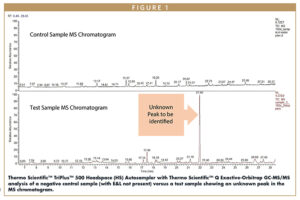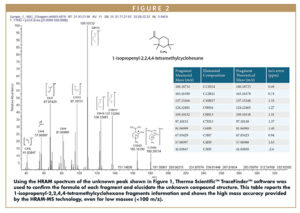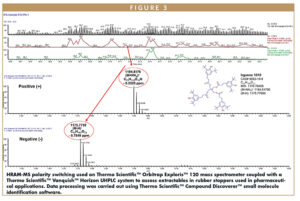Issue:March 2023
EXTRACTABLES & LEACHABLES - Detecting the Unknown With Extractables & Leachables Analysis
INTRODUCTION
Plastic is inextricably linked to drug development: the vast majority of drugs are manufactured in single-use technology utilizing plastic components, stored in primary or secondary plastic packaging, or delivered using plastic devices. This comes as no surprise. Plastic is highly practical, malleable, versatile, hygienic, and low cost, and it helps developers to meet safety standards and reduce the cost of manufacturing.
However, plastic polymers require additives to provide their desired properties. Because additives, such as plasticizers and UV absorbers, aren’t chemically or physically bound to the polymers, they readily migrate from the process, container, packaging, or medical device into the drug product. This migration can create safety risks, including decreased drug stability, active ingredient inactivation, or increased toxicity, and can alter the taste, smell, or color of the drug product.
In the quest to accelerate drug development and improve drug safety, developers must also consider this more problematic side of the plastic revolution. Regulatory bodies are expecting a wider remit on toxicology risk assessments, recognizing that it is not just the drug that needs to be scrutinized but its packaging and manufacturing process too.1 Extractables and leachables (E&L) testing is now required early on in toxicology risk assessments to identify and quantify toxic compounds of interest quickly and accurately.2
Established methodologies already exist for E&L testing, but they are often manual and time-consuming, leaving developers open to escalating costs and error-prone results with limited reproducibility. Developers must err on the side of caution, so every tentative unknown requires an assumption of toxicity. But by falsely categorizing harmless compounds as toxins, whole devices or manufacturing processes may need unnecessary reworking, incurring costs and delays.
A new generation of extraction, identification, and quantification tools, now recognized as approved methods by regulatory bodies, are changing the E&L testing landscape. These methods, based on the latest sample preparation, separation, detection, and analysis technology, look set to cut testing times and related costs while improving result accuracy.3
THE CHALLENGING LANDSCAPE OF EXTRACTABLES & LEACHABLES ANALYSIS
Before we consider the challenges posed by E&L analysis, we must define testing terms. Extractables testing is a “worst-case-scenario” analysis performed on the containers surrounding a drug product: this might be the packaging, processing equipment, or storage solutions. Extreme levels of solvent concentration and/or heat are applied to evaluate the potential risk of chemicals migrating into the drug product, and the resulting extractables are then analyzed.
Leachables testing, however, is performed on the drug product itself. Although accelerated or forced conditions might be used to simulate the passage of time, the analysis aims to investigate compound migration from packaging or medical devices under normal clinical use.
Whatever the drug product and whichever part of the processes or packaging being examined, E&L analysis brings several key challenges. First, leachables and extractables are often unknown compounds — and when these compounds migrate into drug formulations, they can interact with the drug product and form secondary leachables. In turn, these secondary leachables may only be identifiable after conducting stability studies on the drug product.
Second, when working with unknown compounds, surrogate standards are needed to estimate the concentration of the unspecified compounds. When using semi-quantitative methods to evaluate these unknown compounds, uncertainty factors are also required. Depending on the compound, some analytical techniques add more variability than others, and therefore, greater uncertainty. This can make it difficult to accurately quantify the compound of interest.
Finally, the decreasing limits of detection and limits of quantification needed for certain types of compounds mean that part per billion (ppb) and sub-ppb detection requirements are not uncommon. Detection at this level can be challenging.
When working with evermore complex drug formulations, with many potential unknown extractables and leachables, these challenges can prevent accurate and timely detection. Traditional methods that depend largely on time-consuming, manual processes can introduce errors, as well as possible contamination. When quantitative results carry greater uncertainty due to these factors, scientists are forced to intentionally overestimate material or process toxicity to account for the uncertainty in reporting accuracy, which can result in unnecessary costs through process, packaging, or device redesign.
As regulatory requirements, such as the US Pharmacopeia USP 1663 and USP 1664 guidelines, continue to shift and evolve, automated techniques that can deliver the very highest levels of detection and quantification accuracy will become standard practice.4,5
DELIVERING CONFIDENT RESULTS BY IMPROVING ANALYSIS ACCURACY & SPEED
New technologies, software, and workflows based on mass spectrometry (MS) are now being used for E&L analysis to enable faster and more accurate detection and quantification. These systems are highly automated and integrated, supporting the end-to-end workflow from sample extraction to detection, quantification, and analysis. The result: faster and more accurate analysis at a lower cost.
AUTOMATED SAMPLE EXTRACTION
Traditional methods of sample extraction use Soxhlet or solvent reflux to extract materials, but this is a highly manual process that offers poorly reproducible results, despite requiring the skills of specialized analysts. In addition, these techniques can take up to 24 hours to run and require large volumes of solvents, both of which increase costs and limit laboratory throughput.
Automated sample extraction (ASE) is often the first automated technology brought into the E&L analysis workflow. ASE systems use high pressure and high temperature to remove unwanted matrix components and decrease solvent viscosity. This accelerates the diffusion of the analyte into the solvent, helping to achieve very low detection and quantification limits. For this reason, ASE technology is recommended by the PQRI and proposed as a viable method by USP 1663 and USP 1664.6-8
The most advanced ASE systems can automatically extract samples in as little as 15 minutes, using only 10 mL of solvent. These added practical benefits mean that costs are reduced, and analysts are provided with valuable walk-away time.
MULTI-TECHNOLOGY APPROACHES TO SEPARATION & DETECTION
A single sample of extractables or leachables can contain a wide range of unknown compounds of varying volatility. When analyzing unspecified compounds, a surrogate standard is needed, but this introduces uncertainty. Therefore, an uncertainty factor is required to establish the analytical evaluation threshold (the level at which a potential toxin must be declared for a toxicology risk assessment). If the detection technique is well-matched to the compound or class of interest, then this uncertainty can be reduced.
The volatility of the compound generally determines the most effective method of separation and detection, and it makes sense to use a range of technologies for full determination.
Unknown leachable compounds may often be considered non-volatile. Liquid chromatography-mass spectrometry (LC-MS) is often the most effective technology for this separation and detection, especially when the LC element is coupled with high-resolution accurate mass (HRAM) systems. HRAM gives an accurate measure of the mass of ion fragments and this, in turn, helps to identify the compound.
Volatile or semi-volatile leachables, however, are best resolved with gas chromatography-mass spectrometry (GC-MS) systems, due to the technology’s sensitivity and selectivity. Volatile and semi-volatile compounds may constitute a significant portion of the total potential leachables that may be present in a drug product, especially for dry powder products such as from packaging for dry-powder inhalers (DPIs) or for lyophilized products.9 Modern, capillary GC columns can offer increased peak capacity, which leads to excellent chromatographic resolution, along with enhanced reproducibility (Figures 1 and 2).10 Next-generation GC-MS systems can be coupled with simple sample preparation techniques, such as headspace sampling, that efficiently extract volatiles from heavier non-volatile matrix compounds. This quick and simple sampling technique prevents contamination of the analytical system and leads to improved method robustness.
Elemental or organic leachables are often present at very low levels and thus require highly sensitive detection techniques. The latest inductively coupled plasma-mass spectrometry (ICP-MS) systems provide the level of resolution needed to reach even sub-ppb levels of detection.
Alternatives to MS can also be used, such as charged aerosol detection (CAD), to quantify compounds with no ultraviolet chromophore, or diode array detection (DAD) to detect trace levels of semi- or non-volatile species. Another significant advantage of using CAD detection is that when it is used in combination with an inverse gradient, the detected signal is mass proportional, which negates the need for multiple expensive surrogate standards.
EXPANSIVE LIBRARIES & ADVANCED ANALYSIS
Automation software is becoming commonplace in the modern analytics laboratory, removing the manual operation of sample extraction, separation, and detection — and providing scientists with walkaway time to focus on value-added tasks. Now, advanced software is also being used to power sample analysis and provide deep insight into extractables profiles (Figure 2).
For example, HRAM-MS systems can be set to rapidly switch between positive and negative polarity modes to collect data with future use in mind (Figure 3).11 The polarity needed for immediate analysis is achieved, but additional data for the opposite polarity is automatically collected for retrospective analysis at a future date. Gathering this and other fragmentation data from MS2 or MSn modes means that crucial molecular fingerprint information can be collected to aid structure identification and the elucidation of unknown entities.
Many chromatography and MS systems now automatically integrate with comprehensive spectral libraries to aid compound identification and enable them to be rapidly characterized.
E&L ANALYSIS: A POWERFUL ENABLER FOR FASTER & SAFER DRUG DEVELOPMENT
Plastics and their additives are certainly here to stay: the safety, speed, and economies they offer are simply too important to drug developers and the patients they serve. So, as drug developers look to bring new therapies to market quicker and most cost-effectively, E&L analysis will become an ever more important part of that process. Regulatory requirements will continue to evolve, and E&L analysis will need to continue to keep pace, providing that all-important first step toward full toxicology risk assessment.
By investing in the latest technology and software, analytical laboratories can ensure they meet these stringent requirements today, immediately reaping the benefits of speed, accuracy, and efficiency offered by automated systems while keeping pace as regulations morph and evolve.
This investment will help E&L analysis become an enabling part of the pathway as drug developers continue to strive to bring drugs to market faster and more safely. Modern techniques will help to ensure drug safety and efficacy, free from the effects of the manufacturing process, packaging, and delivery mechanism.
REFERENCES
- FDA’S Predictive Toxicology Roadmap, FDA, December 2017. https://www.fda.gov/files/science_&_research/published/FDA’s-Predictive-Toxicology-Roadmap.pdf.
- ICH guideline Q3D (R1) on elemental impurities, European Medicines Agency. https://www.ema.europa.eu/en/documents/scientific-guideline/international-conference-harmonisation-technical-requirements-registration-pharmaceuticals-human-use_en-32.pdf.
- Standardized Extractables Testing Protocol. Pharmaceutical Engineering 34 (2014).
- https://latam-edu.usp.org/wp-content/uploads/2021/01/ USP_NF_1663.pdf.
- https://latam-edu.usp.org/wp-content/uploads/2021/01/ USP_NF_1664.pdf.
- https://pqri.org/wp-content/uploads/2015/08/pdf/LE_Recommendations_to_FDA_09-29-06.pdf.
- https://pqri.org/wp-content/uploads/2022/03/PQRI-PDP-Recommendation-2022.pdf.
- https://pqri.org/wp-content/uploads/2015/08/pdf/ PODP_Workshop_final_02-11.pdf.
- Understanding Leaching from Stoppers into Lyophilized Drugs”, Biopharm International, Steven A. Zdravkovic, PPD, 2019
- Thermo Fisher Scientific. Case study 10683. TriPlus 500 Headspace Autosampler with TRACE 1310 GC and Q Exactive GC-MS/MS system enhances productivity and reliability in pharmaceutical laboratories. Available at: https://assets.thermofisher.com/TFS-Assets/CMD/Reference-Materials/cs-10683-triplus-500-gc-headspace-as-sgs-cs10683-en.pdf.
- Thermo Fisher Scientific. Application Note 000419. Extractable analysis of rubber stoppers for pharmaceutical applications using UHPLC coupled with an Orbitrap Exploris 120 mass spectrometer and Compound Discoverer software. Available at: https://assets.thermofisher.com/TFS-Assets/CMD/Application-Notes/an-000419-lc-ms-extractable-analysis-rubber-stoppers-an000419-na-en.pdf.

Derek Wood is a Senior Principal Scientist at PPD, part of Thermo Fisher Scientific. He earned his Bachelor of Science degree in Biochemistry and has over 30 years of pharmaceutical CRO experience, including 21 years at PPD, where he has served in various positions of scientific and business leadership. Most of his time at PPD has been focused on contributing to PPD’s extractable and leachable (E&L) testing services, a premier service provider of E&L consultation, study design, analytical testing, and toxicity evaluation.

Dr. Xiaochun Yu is a Senior Principal Scientist at PPD, part of Thermo Fisher Scientific. He earned his PhD in Chemistry and has over 20 years of experience in the pharmaceutical industry and over 10 years of experience in academic research in polymer chemistry. He has been leading extractables and leachables (E&L) study since 2003, providing scientific leadership, technical and regulatory guidance to the team and clients for the design and execution of E&L programs. His team has successfully completed hundreds of E&L studies for numerous drug products, including pMDI, DPI, parenteral, ophthalmic, transdermal, and oral dosage forms as well as medical device and drug/device combination products. In the past few years, there have been at least 30 drug products approved with E&L studies completed by his team.

Aaron Lamb is a Pharma and Biopharma Market Development Manager working in the Chromatography and Mass Spectrometry division at Thermo Fisher Scientific, UK. He collaborates with pharmaceutical manufactures and analytical testing labs and is responsible for generating collateral and the planning of pharma campaigns. He has also worked in industry as an R&D and Pharma Team Leader at Intertek using a multitude of analytical techniques including ion chromatography, GC-MS, and LC-MS in healthcare and pharmaceutical analyses.
Total Page Views: 5648



















